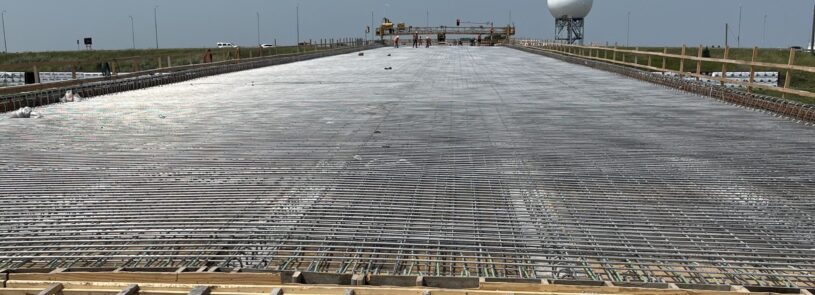Is stainless steel reinforcement the right choice for your bridge?

By Yanling Leng, PhD., PE
A primary way a reinforced concrete bridge deck fails is because the steel reinforcing bar corrodes after its exposed to deicing salt, salt water, and high humidity. As steel corrodes it expands, causing the adjacent concrete to spall, and eventually, the deck to fail. Using stainless steel rebar instead of epoxy-coated steel can prevent this. But the solution has benefits and disadvantages.
The benefits:
- Stainless steel has exceptional resistance to corrosion. It can significantly extend the lifespan of a bridge deck, reducing the need for frequent maintenance and repair, which saves money in the long term. (IMEG is currently working on the Benson Road Bridge in Sioux Falls, SD. Its previous bridge deck, which used epoxy reinforcement steel, suffered from significant delamination and had to be removed and replaced. We exclusively employed stainless steel for the concrete deck, barriers, and approach slabs, to ensure a longer service life. A key challenge was removing the existing concrete slab without damaging the pre-stressed concrete girders beneath it.)
- Bridges reinforced with stainless steel can last decades longer than those using conventional materials. This means lower lifecycle costs, reduced maintenance needs, and fewer emergency repairs. (IMEG provided construction engineering, materials testing, and inspection for several components of the new I-74 Mississippi River bridge in the Quad-Cities. Its design employed stainless steel exclusively, including in the barriers, to provide a long service life and minimize the need for extensive maintenance and frequent deck replacement.)
- Stainless steel provides comparable or better strength compared to traditional steel reinforcement. This potentially can allow for the design of thinner decks and reduction of material use and weight.
- In some cases, the use of stainless steel can enhance the aesthetic quality of a bridge.
The disadvantages:
- The upfront cost of stainless steel reinforcement is significantly higher than conventional steel. Over the life of the bridge, this should be offset by the reduced need for maintenance and repairs, but the initial investment may be a deterrent in some areas.
- Using stainless steel reinforcement may require specialized knowledge and training for design and construction. Are your engineers and contractors familiar with the specific properties and handling requirements that will ensure the best performance?
- In some regions, stainless steel reinforcement may not be readily available, which could delay project timelines. You should ensure your suppliers can meet your demands for these materials before design begins.
- When stainless steel is used with traditional steel or other metals, there is a risk of galvanic corrosion if not properly isolated. Careful planning and execution during the design phase can mitigate risks.
- Although stainless steel is strong, it is heavier than some alternative materials. This can affect construction and may require more consideration for the overall design and structural support of the bridge.
Transportation officials must consider their needs, budgets, and long-term goals to decide whether stainless steel is the right choice for their bridge projects. Your consulting engineer can offer advice on whether it makes sense for your next bridge project.












